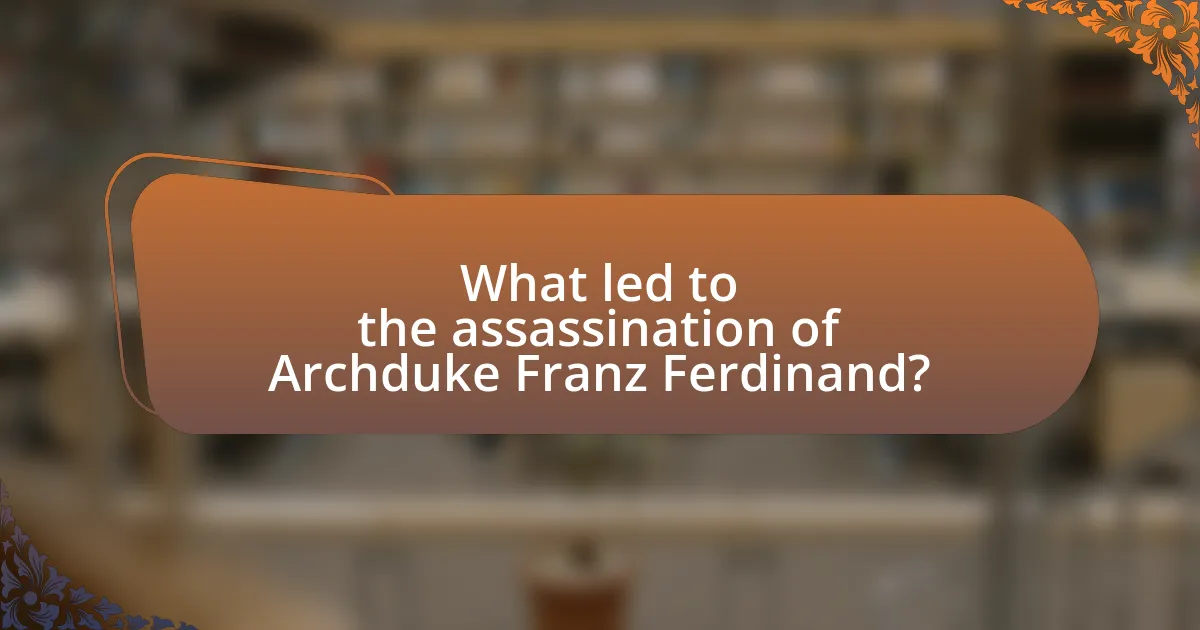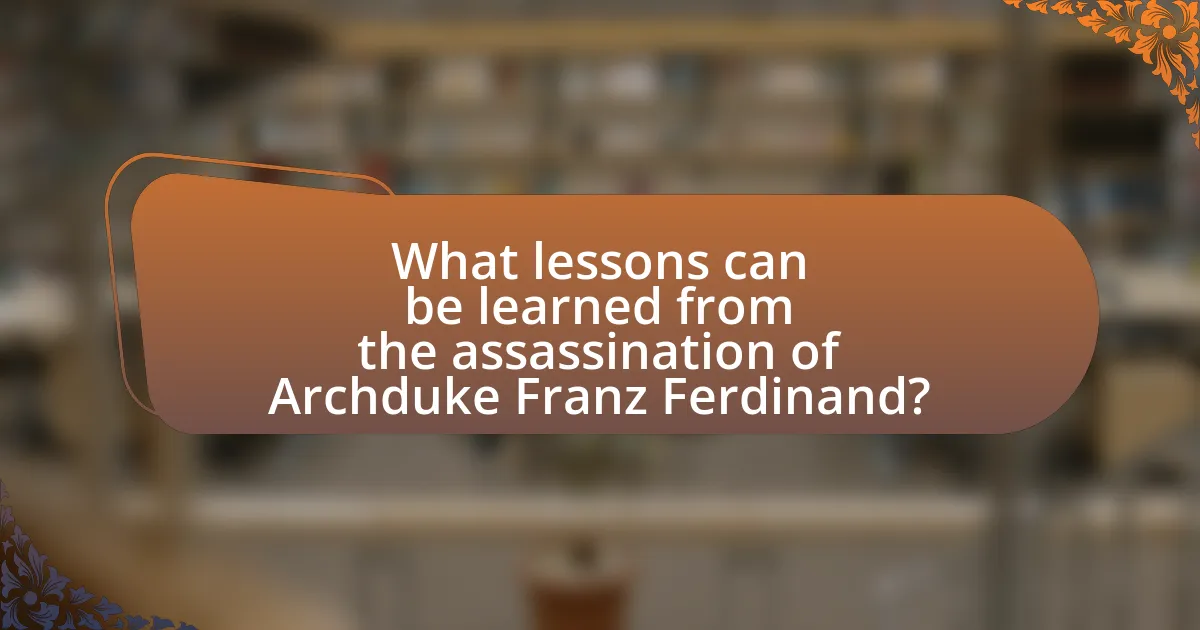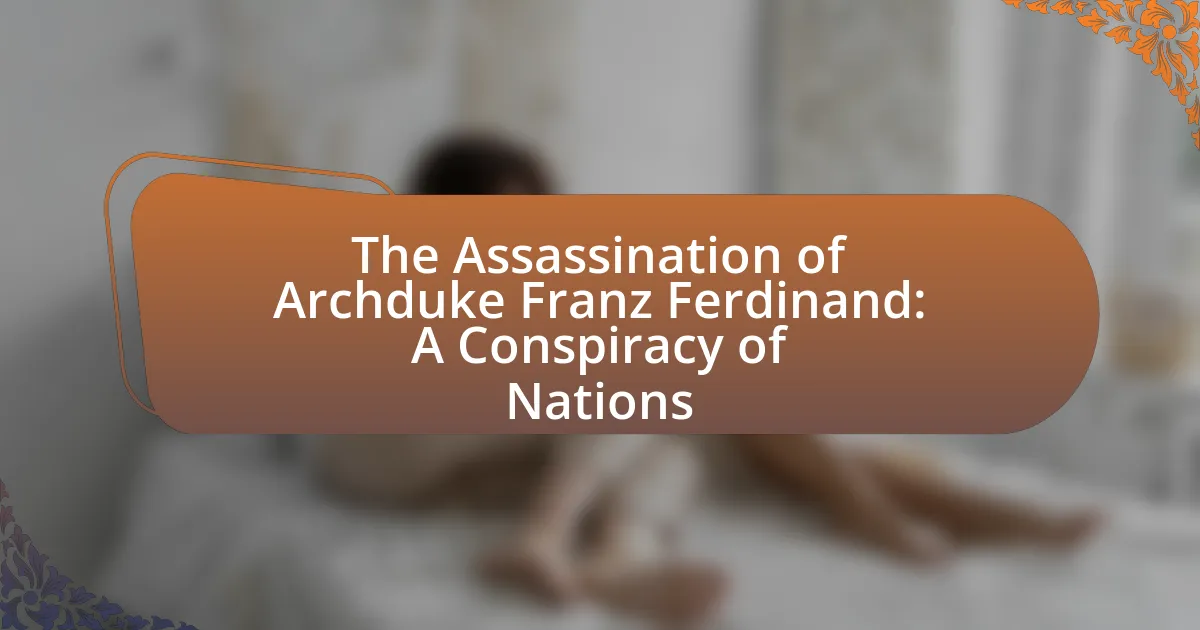The assassination of Archduke Franz Ferdinand on June 28, 1914, serves as a pivotal event that triggered World War I, rooted in nationalist tensions and political rivalries in Europe. The article explores the motivations behind the assassination, particularly the role of Serbian nationalism and the Black Hand organization, as well as the complex web of alliances that escalated the conflict. It examines the immediate consequences of the assassination, including Austria-Hungary’s aggressive response and the subsequent mobilization of major powers, ultimately reshaping the geopolitical landscape of Europe. Additionally, the article highlights the lessons learned from this historical event regarding diplomacy, conflict resolution, and the management of nationalist tensions.

What led to the assassination of Archduke Franz Ferdinand?
The assassination of Archduke Franz Ferdinand was primarily led by nationalist tensions in the Balkans, particularly the desire for Serbian independence from Austro-Hungarian rule. This desire was fueled by the broader context of rising nationalism and ethnic conflicts in the region, as well as the political climate following the Austro-Hungarian annexation of Bosnia and Herzegovina in 1908, which angered Serbia and its allies. The specific act was carried out by Gavrilo Princip, a member of the nationalist group known as the Black Hand, which sought to promote Slavic nationalism and oppose Austro-Hungarian dominance. This assassination on June 28, 1914, directly triggered a series of events that led to the outbreak of World War I, as it escalated existing tensions between major powers in Europe.
How did the political climate in Europe contribute to the assassination?
The political climate in Europe significantly contributed to the assassination of Archduke Franz Ferdinand by fostering nationalist tensions and rivalries among nations. The early 20th century was marked by a complex web of alliances and a rise in nationalist sentiments, particularly in the Balkans, where Slavic nationalism was gaining momentum against Austro-Hungarian rule. This environment of political instability and competition created a fertile ground for radical groups, such as the Black Hand, which sought to achieve their goals through violent means. The assassination on June 28, 1914, was a direct result of these heightened tensions, as the assassin, Gavrilo Princip, was motivated by the desire to liberate South Slavs from Austro-Hungarian control, reflecting the broader nationalist aspirations that were prevalent in Europe at the time.
What were the key alliances and tensions among nations at the time?
The key alliances at the time of the assassination of Archduke Franz Ferdinand included the Triple Alliance, consisting of Germany, Austria-Hungary, and Italy, and the Triple Entente, which comprised France, Russia, and the United Kingdom. These alliances created a polarized environment in Europe, leading to heightened tensions. The assassination on June 28, 1914, by a Bosnian Serb nationalist intensified existing rivalries, particularly between Austria-Hungary and Serbia, with Austria-Hungary seeking support from Germany to take a hard stance against Serbia. This situation escalated into a broader conflict as Russia mobilized to support Serbia, leading to the outbreak of World War I. The interlocking alliances and nationalistic fervor contributed significantly to the rapid escalation of tensions into a full-scale war.
How did nationalism play a role in the events leading up to the assassination?
Nationalism significantly influenced the events leading up to the assassination of Archduke Franz Ferdinand by fostering tensions among various ethnic groups within the Austro-Hungarian Empire. The rise of nationalist movements, particularly among Serbs, sought independence and the unification of Slavic peoples, which directly challenged the empire’s authority. This atmosphere of heightened nationalism motivated Gavrilo Princip, a member of the nationalist group known as the Black Hand, to assassinate the Archduke on June 28, 1914, as a means to promote Serbian nationalism and oppose Austro-Hungarian rule. The assassination was thus not merely an isolated act but a culmination of nationalist fervor that aimed to reshape the political landscape of Southeast Europe.
Who were the key figures involved in the assassination plot?
The key figures involved in the assassination plot of Archduke Franz Ferdinand were Gavrilo Princip, Nedeljko Cabrinovic, and other members of the Black Hand organization. Gavrilo Princip was the assassin who fired the fatal shots on June 28, 1914, while Nedeljko Cabrinovic attempted to throw a grenade at the Archduke’s motorcade earlier that day. The Black Hand, a secret society advocating for the unification of South Slavs, orchestrated the assassination as part of their nationalist agenda. This plot ultimately contributed to the outbreak of World War I, highlighting the significant impact of these individuals on historical events.
What was the role of Gavrilo Princip in the assassination?
Gavrilo Princip was the assassin who killed Archduke Franz Ferdinand of Austria on June 28, 1914. Princip, a member of the nationalist group known as the Black Hand, fired two shots at the Archduke and his wife, Sophie, resulting in their deaths. This act was a pivotal moment that contributed to the outbreak of World War I, as it escalated tensions between Austria-Hungary and Serbia, leading to a complex web of alliances and conflicts.
Who were the members of the Black Hand and what were their motivations?
The Black Hand was a secret society formed in Serbia, primarily composed of military officers and nationalists, including notable members such as Dragutin Dimitrijević, also known as Apis, and other influential figures like Vojislav Tankosić and Gavrilo Princip. Their primary motivation was to promote Serbian nationalism and to oppose Austro-Hungarian rule over Bosnia and Herzegovina, which they viewed as a threat to Serbian sovereignty. The assassination of Archduke Franz Ferdinand in 1914 was a direct result of their efforts to incite a rebellion against Austro-Hungarian authority, aiming to unify South Slavic peoples under Serbian leadership. This act was intended to spark a larger conflict that would ultimately lead to the liberation of Serbs from Austro-Hungarian control.
What were the immediate consequences of the assassination?
The immediate consequences of the assassination of Archduke Franz Ferdinand included the escalation of tensions between Austria-Hungary and Serbia, leading to the outbreak of World War I. Following the assassination on June 28, 1914, Austria-Hungary issued an ultimatum to Serbia, which contained demands that were intentionally harsh. Serbia’s response was deemed unsatisfactory, prompting Austria-Hungary to declare war on July 28, 1914. This declaration triggered a series of alliances and mobilizations among European powers, resulting in a widespread conflict that involved multiple nations and ultimately reshaped the geopolitical landscape of the time.
How did the assassination impact Austria-Hungary’s response?
The assassination of Archduke Franz Ferdinand significantly escalated Austria-Hungary’s response towards Serbia, leading to a declaration of war. Following the assassination on June 28, 1914, Austria-Hungary viewed Serbia as responsible for the act, primarily due to the involvement of Serbian nationalist groups. This perception prompted Austria-Hungary to issue an ultimatum to Serbia on July 23, 1914, which included demands that were intentionally stringent to provoke a conflict. Serbia’s partial acceptance of the ultimatum was deemed insufficient, resulting in Austria-Hungary declaring war on Serbia on July 28, 1914. This decisive action marked the beginning of a chain reaction among the major powers of Europe, ultimately leading to World War I.
What was the reaction of other nations to the assassination?
The assassination of Archduke Franz Ferdinand in June 1914 prompted a swift and varied reaction from other nations. Austria-Hungary, seeking to assert its power, issued an ultimatum to Serbia, which was seen as a direct challenge by Russia, leading to heightened tensions. Germany supported Austria-Hungary, encouraging a hardline approach, while France and Britain expressed concern over the potential for conflict. The assassination ultimately set off a chain reaction of alliances and mobilizations, culminating in the outbreak of World War I, as nations reacted to the shifting balance of power in Europe.

How did the assassination escalate into a global conflict?
The assassination of Archduke Franz Ferdinand on June 28, 1914, escalated into a global conflict primarily due to the complex web of alliances and nationalistic tensions in Europe. Following the assassination, Austria-Hungary issued an ultimatum to Serbia, which contained demands that were intentionally provocative. Serbia’s response, while conciliatory, did not fully satisfy Austria-Hungary, leading to its declaration of war on July 28, 1914. This act triggered a series of alliances: Russia mobilized to support Serbia, Germany declared war on Russia, and subsequently on France, while Britain entered the conflict after Germany invaded Belgium. The interconnected alliances and the prevailing militaristic and nationalistic sentiments among the major powers transformed a regional dispute into World War I, involving multiple nations across the globe.
What were the diplomatic responses following the assassination?
Following the assassination of Archduke Franz Ferdinand on June 28, 1914, the diplomatic responses included Austria-Hungary’s issuance of an ultimatum to Serbia, which contained demands that were intentionally stringent. Austria-Hungary sought to use the assassination as a pretext to assert its influence over the Balkans and suppress Serbian nationalism. The ultimatum, delivered on July 23, 1914, allowed Serbia only 48 hours to respond, reflecting Austria-Hungary’s aggressive stance. Serbia’s response, which accepted most but not all of the demands, was deemed unsatisfactory by Austria-Hungary, leading to the declaration of war on July 28, 1914. This escalation prompted a series of alliances to activate, drawing in major powers such as Russia, Germany, and France, ultimately leading to the outbreak of World War I. The diplomatic responses were characterized by a failure to resolve tensions peacefully, highlighting the fragility of international relations at the time.
How did Austria-Hungary’s ultimatum to Serbia contribute to the outbreak of war?
Austria-Hungary’s ultimatum to Serbia directly contributed to the outbreak of war by escalating tensions between the two nations and triggering a series of alliances that led to a broader conflict. The ultimatum, issued on July 23, 1914, contained demands that were intentionally harsh and nearly impossible for Serbia to accept fully, including the suppression of anti-Austrian propaganda and the involvement of Austro-Hungarian officials in the investigation of the assassination of Archduke Franz Ferdinand. Serbia’s partial acceptance of the ultimatum on July 25 was deemed insufficient by Austria-Hungary, which declared war on July 28, 1914. This declaration activated a network of alliances, as Russia mobilized to support Serbia, leading Germany to declare war on Russia, and subsequently on France and Belgium, thus igniting World War I. The ultimatum’s role as a catalyst for these events illustrates how diplomatic failures and nationalistic tensions can escalate into widespread conflict.
What role did Germany play in supporting Austria-Hungary?
Germany played a crucial role in supporting Austria-Hungary by providing diplomatic and military backing during the July Crisis of 1914. Following the assassination of Archduke Franz Ferdinand, Germany issued the “Blank Check” assurance to Austria-Hungary, promising unconditional support against Serbia. This commitment emboldened Austria-Hungary to take a hardline stance, ultimately leading to the declaration of war on Serbia, which triggered the wider conflict of World War I. The German leadership believed that supporting Austria-Hungary was essential to maintaining their alliance and countering Russian influence in the Balkans, thereby solidifying their position in European geopolitics.
Why did alliances lead to a larger conflict?
Alliances led to a larger conflict because they created a web of obligations that compelled nations to support each other in times of crisis. For instance, the assassination of Archduke Franz Ferdinand in 1914 triggered Austria-Hungary to declare war on Serbia, which activated Russia’s alliance with Serbia. This action prompted Germany, allied with Austria-Hungary, to declare war on Russia, subsequently drawing in France and Britain due to their own alliances. The interconnected nature of these alliances escalated a regional conflict into a full-scale war, as seen in World War I, where major powers were drawn in due to their commitments to defend their allies.
How did the system of alliances in Europe create a domino effect?
The system of alliances in Europe created a domino effect by binding countries to mutual defense agreements, which escalated a localized conflict into a widespread war. When Archduke Franz Ferdinand was assassinated in June 1914, Austria-Hungary declared war on Serbia, invoking its alliance with Germany. This action triggered Russia’s alliance with Serbia, leading to Germany declaring war on Russia. Subsequently, France, allied with Russia, was drawn into the conflict, and Germany’s invasion of Belgium brought Britain into the war due to its treaty obligations. This chain reaction illustrates how interconnected alliances transformed a single assassination into World War I, demonstrating the precarious nature of diplomatic agreements in Europe at the time.
What were the implications of the assassination for the balance of power in Europe?
The assassination of Archduke Franz Ferdinand in 1914 significantly destabilized the balance of power in Europe, leading to the outbreak of World War I. This event triggered a series of alliances and military mobilizations among European powers, as Austria-Hungary sought to punish Serbia, which it blamed for the assassination. The resulting conflict escalated due to existing alliances, such as those between Germany and Austria-Hungary, and Russia’s support for Serbia, ultimately drawing in major powers like France and Britain. The war that ensued altered territorial boundaries, diminished empires, and set the stage for future geopolitical tensions, fundamentally reshaping the political landscape of Europe.

What lessons can be learned from the assassination of Archduke Franz Ferdinand?
The assassination of Archduke Franz Ferdinand teaches the importance of understanding the complex interplay of political tensions and alliances. This event triggered World War I, highlighting how a single incident can escalate into widespread conflict due to existing rivalries and nationalistic fervor. The assassination underscored the necessity for diplomatic communication and conflict resolution mechanisms to prevent misunderstandings that can lead to war. Historical analysis shows that the failure of European powers to effectively manage their alliances and address grievances contributed significantly to the outbreak of hostilities, demonstrating that proactive engagement is crucial in international relations.
How can understanding this event help prevent future conflicts?
Understanding the assassination of Archduke Franz Ferdinand can help prevent future conflicts by highlighting the complex interplay of nationalism, alliances, and political tensions that led to World War I. Analyzing this event reveals how miscommunication and the failure of diplomatic channels can escalate tensions into violence. Historical evidence shows that the assassination triggered a series of alliances and retaliatory actions, ultimately resulting in a global conflict. By studying these dynamics, policymakers can recognize the importance of effective communication, conflict resolution strategies, and the need for multilateral dialogue to address grievances before they escalate into violence.
What strategies can nations employ to manage nationalist tensions?
Nations can manage nationalist tensions through inclusive governance, dialogue, and economic integration. Inclusive governance involves ensuring representation of diverse ethnic and national groups in political processes, which can reduce feelings of marginalization. For example, countries like Canada have implemented policies that promote multiculturalism, fostering a sense of belonging among various communities.
Dialogue initiatives, such as peace talks and community engagement programs, can facilitate understanding and reconciliation between conflicting nationalist groups. Historical examples include the Good Friday Agreement in Northern Ireland, which addressed nationalist tensions through negotiation and compromise.
Economic integration, through trade agreements and joint economic projects, can create interdependence among different national groups, reducing the likelihood of conflict. The European Union exemplifies this strategy, as it has promoted economic collaboration among member states, contributing to stability in a region historically marked by nationalist strife.
How can diplomacy be improved to avoid escalation of conflicts?
Diplomacy can be improved to avoid escalation of conflicts by enhancing communication channels among nations. Effective communication reduces misunderstandings and fosters trust, which is crucial in conflict resolution. Historical examples, such as the establishment of the United Nations after World War II, demonstrate that multilateral dialogue can prevent conflicts from escalating into wars. Additionally, employing conflict resolution frameworks, like the Harvard Negotiation Project, emphasizes interest-based negotiation, which can lead to mutually beneficial outcomes and reduce tensions.
What are the historical interpretations of the assassination’s significance?
The assassination of Archduke Franz Ferdinand is historically interpreted as a catalyst for World War I, marking the beginning of a series of events that escalated into a global conflict. Historians argue that the assassination highlighted the tensions between major powers, particularly Austria-Hungary and Serbia, and demonstrated the fragility of peace in Europe. The event is often viewed through the lens of nationalism, imperialism, and the complex web of alliances that characterized early 20th-century geopolitics. For instance, the July Crisis of 1914, which followed the assassination, illustrates how the assassination triggered diplomatic failures and militaristic responses, ultimately leading to the war. Additionally, some interpretations emphasize the role of the assassination in reshaping national identities and political landscapes in Europe, as it prompted a reevaluation of alliances and enmities among nations.
How do historians view the assassination in the context of World War I?
Historians view the assassination of Archduke Franz Ferdinand as a pivotal event that directly contributed to the outbreak of World War I. This assassination, which occurred on June 28, 1914, is often seen as the spark that ignited existing tensions among European powers, particularly between Austria-Hungary and Serbia. The assassination led Austria-Hungary to issue an ultimatum to Serbia, which, when not fully accepted, resulted in the declaration of war. This sequence of events illustrates how the assassination acted as a catalyst in a complex web of alliances and militaristic posturing, ultimately leading to a global conflict. Historians emphasize that the assassination was not an isolated incident but rather a culmination of nationalist sentiments and geopolitical rivalries that had been building for years, making it a critical factor in the war’s inception.
What alternative outcomes could have arisen from different responses to the assassination?
Different responses to the assassination of Archduke Franz Ferdinand could have led to various alternative outcomes, including the prevention of World War I or a different geopolitical landscape in Europe. If Austria-Hungary had chosen diplomacy over military action against Serbia, tensions might have eased, potentially averting the war. Conversely, a more aggressive response could have escalated conflicts, drawing in additional nations sooner and altering alliances. Historical context shows that the assassination was a catalyst for existing tensions; thus, varying responses could have significantly changed the course of history, as evidenced by the complex web of alliances and rivalries in early 20th-century Europe.
What practical steps can be taken to analyze similar historical events?
To analyze similar historical events, researchers should first gather primary and secondary sources related to the event, such as official documents, eyewitness accounts, and scholarly articles. This step is crucial because it provides a comprehensive understanding of the context and perspectives surrounding the event. Next, researchers should identify key themes and patterns by comparing the event with other historical occurrences, focusing on factors like political motivations, social dynamics, and international relations. For instance, the assassination of Archduke Franz Ferdinand in 1914 can be compared to the assassination of President John F. Kennedy in 1963 to explore the impact of political violence on global relations. Finally, employing analytical frameworks, such as historical causation or the theory of collective action, can help in drawing conclusions about the implications of the event. This methodical approach ensures a thorough and nuanced analysis of historical events.
